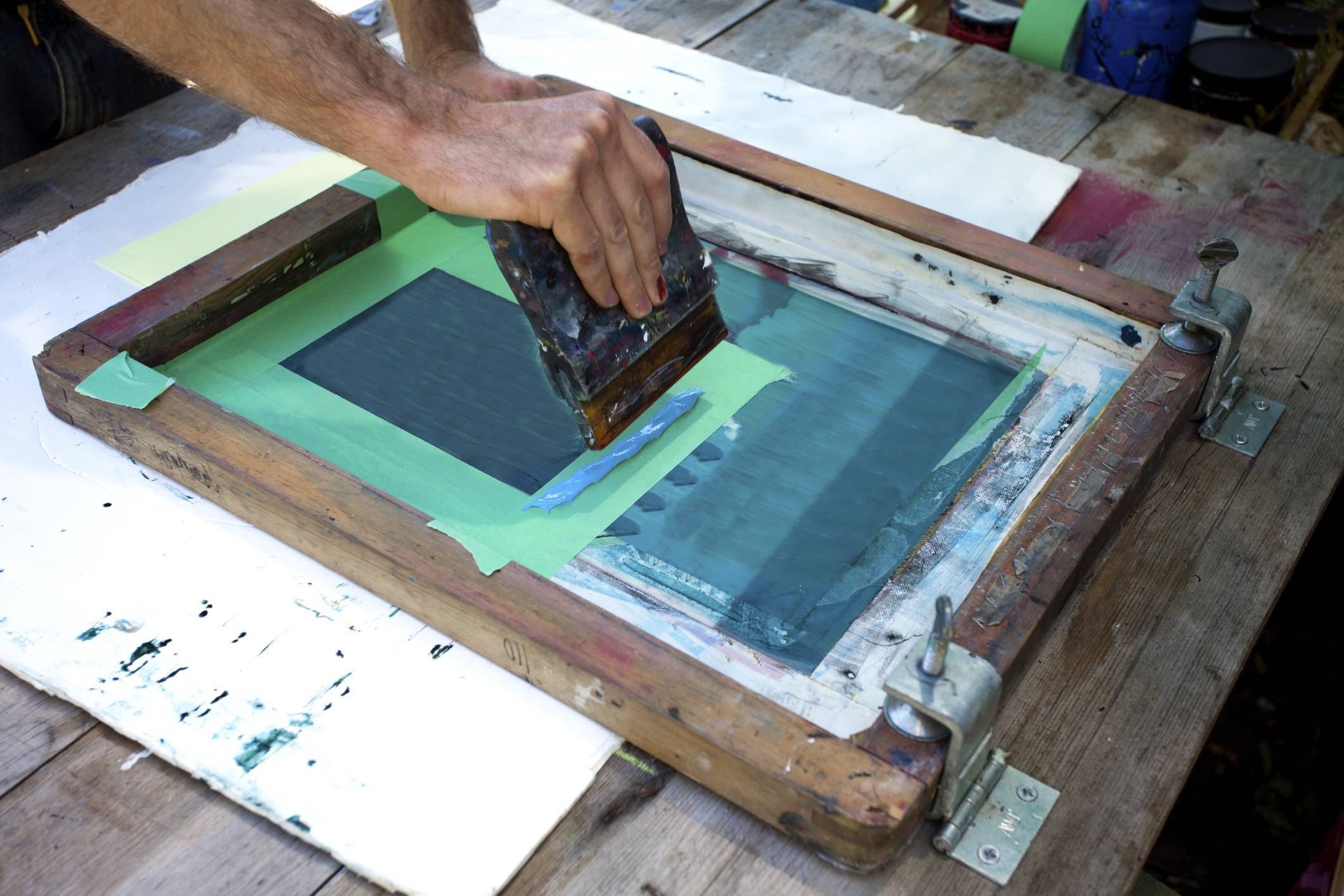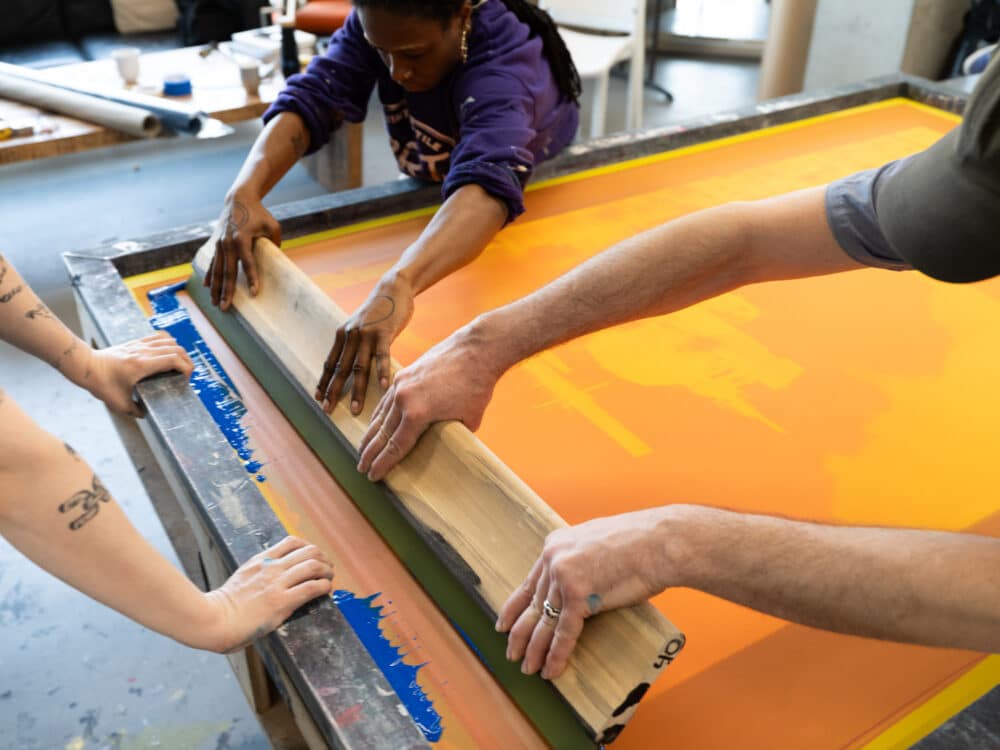Discover the Numerous Kinds of Screen Printing Techniques for Your Next Project
Screen printing supplies a diverse variety of methods that can boost any type of imaginative job. From conventional techniques like serigraphy to modern advancements such as direct-to-garment printing, each approach has its distinct benefits. Specialty options, including metallic and environmentally friendly inks, introduce also extra opportunities. Comprehending these techniques can greatly influence the last end result. The challenge lies in choosing the most appropriate approach for particular demands and wanted effects. What aspects should one take into consideration?

The Fundamentals of Screen Printing
Although screen printing may appear complicated, it is fundamentally a straightforward process that involves transferring ink via a mesh screen onto different surfaces. The method starts with the development of a pattern, which defines the style to be published. This pattern is connected to a mesh screen, commonly made of polyester or nylon. When the pattern is in area, ink is used to the screen and pressed with the mesh making use of a squeegee, resulting in the wanted pattern being published on the underlying material.
Screen printing can be done on a vast array of substrates, consisting of paper, plastic, and textile, making it a versatile choice for different jobs. The procedure permits complex designs and lively colors, making it prominent in industries such as fashion, art, and advertising. Recognizing these fundamentals equips individuals with the foundational understanding required to explore advanced methods in screen printing.
Conventional Screen Printing Techniques
Typical screen printing techniques have been used for centuries, preserving the workmanship and virtuosity of this approach. This technique utilizes a mesh screen to move ink onto a substrate, such as material or paper, allowing for dynamic and resilient styles. The procedure starts with developing a stencil, which obstructs certain locations of the screen to control where the ink will certainly be used.
One prominent method is serigraphy, often used for artistic prints and limited versions. One more is making use of water-based inks, which are environment-friendly and provide a soft feeling on textiles - 10:9 Design Screen Printing Texas. Furthermore, standard methods can consist of hands-on printing, where artisans apply ink with a squeegee, guaranteeing precision and interest to detail
These methods stay valued in the market for their tactile top quality and the special structures they generate, appealing to both consumers and designers that appreciate the heritage of screen printing.
Digital Screen Printing Innovations
As the need for faster manufacturing and customization in the printing industry has surged, digital screen printing advancements have become a game-changer. This technology blends standard screen printing methods with electronic processes, permitting rapid prototyping and intricate styles that were formerly difficult to attain. One substantial development is the intro of direct-to-garment (DTG) printing, which promotes high-quality, full-color prints on numerous fabrics without the demand for screens. In addition, developments in ink solutions have actually led to eco-friendly alternatives that keep vivid shades while reducing ecological influence. Making use of automated systems better improves manufacturing, minimizing labor costs and boosting accuracy. These developments not just provide to tiny batch orders and individualized designs but additionally permit quicker turnaround times, making them ideal for businesses concentrated on meeting client demands in a fast-paced market. Digital screen printing, subsequently, represents an important advancement in the domain name of printing methods.
Specialty Screen Printing Approaches
Discovering specialized screen printing techniques discloses a diverse variety of techniques that push the limits of imagination and capability in the printing market. Amongst these, glow-in-the-dark inks offer an one-of-a-kind visual impact, making layouts come to life in low-light conditions. Metallic inks, known for their glittering coating, include a touch of high-end to check here printed products. One more ingenious technique is discharge printing, which eliminates color from the material rather than including ink, causing a soft, classic feel. High-density printing creates a raised structure externally, improving responsive engagement. Furthermore, water-based inks are acquiring appeal for their vivid colors and reduced ecological impact. Each of these specialty methods satisfies details layout requirements, allowing brand names and musicians to produce standout items that resonate with their audiences. By leveraging these techniques, services can boost their screen printing tasks to brand-new heights, ensuring memorable perceptions.
Eco-Friendly Screen Printing Options
Eco-friendly screen printing alternatives are gaining grip as the industry shifts in the direction of sustainability. Sustainable ink options and the use of eco-friendly products are essential components in reducing the environmental influence of the printing process. By embracing these techniques, screen printers can add to a much more sustainable future while maintaining high-grade results.
Lasting Ink Options

Biodegradable Materials Usage
As the screen printing sector develops, the incorporation of biodegradable materials is ending up being progressively important for ecologically aware practices. Developers and suppliers are now exploring inks and substratums made from natural, renewable energies that decompose a lot more effectively than traditional counterparts. These eco-friendly alternatives lower plastic waste and decrease environmental impact, aligning with the expanding need for lasting products.
Typical instances consist of water-based inks and organic cotton materials, both of which minimize dangerous chemicals and promote eco-friendliness. Brand names that embrace these materials typically improve their market allure, bring in customers who prioritize sustainability. As recognition of ecological issues continues to increase, the change towards eco-friendly products in screen printing is most likely to obtain energy, fostering a greener industry requirement.
Selecting the Right Strategy for Your Project
Exactly how can one establish one of the most ideal screen printing strategy for a details job? The decision rests on several aspects, consisting of the product to be published on, the intricacy of the style, and the preferred manufacturing volume - 10:9 Design Embroidery. Direct-to-garment printing is ideal for detailed designs with various colors, while conventional screen printing stands out for larger runs of less complex graphics.
Additionally, consideration of the end-use of the published item is important. For exterior applications, strategies that supply resilience and weather condition resistance, such as plastisol ink, might be chosen. Conversely, environmentally-conscious tasks might take advantage of water-based inks or biodegradable materials.
Inevitably, recognizing the job's distinct demands enables an educated option, making sure both aesthetic allure and useful longevity. By examining design intricacy, material compatibility, and production range, one can efficiently select the most ideal screen printing technique to fulfill their job's goals.
Often Asked Concerns
What Is the History of Screen Printing?
Screen printing originated in old China around 1000 AD, evolving through Japan and Europe. By the 20th century, it became preferred in business art and fashion, revolutionizing exactly how designs were created and dispersed globally.

Exactly how Do I Prepare Art Work for Screen Printing?
To prepare art work for screen printing, one should assure high resolution, make use of an appropriate shade setting, develop separate layers for each and every shade, and transform text to lays out, assuring compatibility with the printing procedure and wanted outcome.
What Materials Are Finest for Screen Printing?
The finest materials for screen printing include top notch inks, long lasting displays, and appropriate substratums like cotton, polyester, or blends. Furthermore, utilizing suitable emulsion and squeegees can boost the printing process and results.
Can I Screen Publish in the house?
Yes, screen printing in your home is feasible. With the appropriate products, setup, and strategies, people can develop premium prints. Careful consideration of work space and devices is essential for successful results.
What Are Usual Mistakes in Screen Printing?
Common mistakes in screen printing consist of incorrect exposure times, inadequate ink consistency, imbalance of displays, inadequate cleaning of materials, and disregarding to examine prints. These errors can compromise the quality and precision of the end product.
Screen printing may seem facility, it is essentially a straightforward process that entails moving ink via a mesh screen onto different surface areas. As the demand for faster manufacturing and modification in the printing market has actually risen, electronic screen printing developments have emerged as a game-changer. Checking out specialty screen printing methods exposes a diverse range of methods that press the limits of imagination and performance in the printing market. The finest products for screen printing consist of high-quality inks, durable displays, and suitable substratums like cotton, polyester, or blends (10:9 Design Texas). Usual errors in screen printing consist of inappropriate exposure times, inadequate ink consistency, imbalance of displays, inadequate cleaning of materials, and neglecting to examine prints